TP-Link Archer C54 Manual

User Guide
AC1200 Dual Band Wi-Fi Router
Archer C54
REV1.0.0 1910012708
Contents
About This Guide . . . . . . . . . . . . . . . . . . . . . . . . . . . . . . . . . . . . . . . . . . . . . . . . . . . . . 1
Chapter 1. Get to Know About Your Router . . . . . . . . . . . . . . . . . . . . . . . . . . . 3
1. 1. Product Overview . . . . . . . . . . . . . . . . . . . . . . . . . . . . . . . . . . . . . . . . . . . . . . . . . . . . . . . . . . . .4 1. 2. Appearance. . . . . . . . . . . . . . . . . . . . . . . . . . . . . . . . . . . . . . . . . . . . . . . . . . . . . . . . . . . . . . . . . .4 1. 2. 1.Top Panel . . . . . . . . . . . . . . . . . . . . . . . . . . . . . . . . . . . . . . . . . . . . . . . . . . . . . . . . . . . . . .4 1. 2. 2.The Back Panel . . . . . . . . . . . . . . . . . . . . . . . . . . . . . . . . . . . . . . . . . . . . . . . . . . . . . . . .5 1. 2. 3.The Bottom. . . . . . . . . . . . . . . . . . . . . . . . . . . . . . . . . . . . . . . . . . . . . . . . . . . . . . . . . . . .6
Chapter 2. Connect to the Internet. . . . . . . . . . . . . . . . . . . . . . . . . . . . . . . . . . . 7
2. 1. Position Your Router. . . . . . . . . . . . . . . . . . . . . . . . . . . . . . . . . . . . . . . . . . . . . . . . . . . . . . . . . .8 2. 2. Connect to the Internet . . . . . . . . . . . . . . . . . . . . . . . . . . . . . . . . . . . . . . . . . . . . . . . . . . . . . . 9 2. 2. 1.Wireless Router Mode . . . . . . . . . . . . . . . . . . . . . . . . . . . . . . . . . . . . . . . . . . . . . . . . .9 2. 2. 2.Range Extender Mode . . . . . . . . . . . . . . . . . . . . . . . . . . . . . . . . . . . . . . . . . . . . . . . 11 2. 2. 3.Access Point Mode . . . . . . . . . . . . . . . . . . . . . . . . . . . . . . . . . . . . . . . . . . . . . . . . . . 12
Chapter 3. Log In to the Router . . . . . . . . . . . . . . . . . . . . . . . . . . . . . . . . . . . . . 14
Chapter 4. Configure the Router in Wireless Router Mode. . . . . . . . . . . 16
4. 1. Operation Mode. . . . . . . . . . . . . . . . . . . . . . . . . . . . . . . . . . . . . . . . . . . . . . . . . . . . . . . . . . . . 17 4. 2. Network. . . . . . . . . . . . . . . . . . . . . . . . . . . . . . . . . . . . . . . . . . . . . . . . . . . . . . . . . . . . . . . . . . . . 17 4. 2. 1.Status . . . . . . . . . . . . . . . . . . . . . . . . . . . . . . . . . . . . . . . . . . . . . . . . . . . . . . . . . . . . . . . 17 4. 2. 2.Internet. . . . . . . . . . . . . . . . . . . . . . . . . . . . . . . . . . . . . . . . . . . . . . . . . . . . . . . . . . . . . . 19 4. 2. 3.MAC Clone . . . . . . . . . . . . . . . . . . . . . . . . . . . . . . . . . . . . . . . . . . . . . . . . . . . . . . . . . . 25 4. 2. 4. LAN . . . . . . . . . . . . . . . . . . . . . . . . . . . . . . . . . . . . . . . . . . . . . . . . . . . . . . . . . . . . . . . 26 4. 2. 5. IPTV . . . . . . . . . . . . . . . . . . . . . . . . . . . . . . . . . . . . . . . . . . . . . . . . . . . . . . . . . . . . . . . 26 4. 2. 6.DHCP Server . . . . . . . . . . . . . . . . . . . . . . . . . . . . . . . . . . . . . . . . . . . . . . . . . . . . . . . . 27 4. 2. 7.Dynamic DNS. . . . . . . . . . . . . . . . . . . . . . . . . . . . . . . . . . . . . . . . . . . . . . . . . . . . . . . . 29 4. 2. 8.Static Routing . . . . . . . . . . . . . . . . . . . . . . . . . . . . . . . . . . . . . . . . . . . . . . . . . . . . . . . 30
4. 3. Wireless . . . . . . . . . . . . . . . . . . . . . . . . . . . . . . . . . . . . . . . . . . . . . . . . . . . . . . . . . . . . . . . . . . . 31 4. 3. 1.Wireless Settings . . . . . . . . . . . . . . . . . . . . . . . . . . . . . . . . . . . . . . . . . . . . . . . . . . . . 31 4. 3. 2.Guest Network. . . . . . . . . . . . . . . . . . . . . . . . . . . . . . . . . . . . . . . . . . . . . . . . . . . . . . . 33 4. 3. 3.Wireless Schedule . . . . . . . . . . . . . . . . . . . . . . . . . . . . . . . . . . . . . . . . . . . . . . . . . . . 34 4. 3. 4. WPS . . . . . . . . . . . . . . . . . . . . . . . . . . . . . . . . . . . . . . . . . . . . . . . . . . . . . . . . . . . . . . . 35
4. 3. 5.Additional Wireless Settings . . . . . . . . . . . . . . . . . . . . . . . . . . . . . . . . . . . . . . . . . 37 4. 4. NAT Forwarding . . . . . . . . . . . . . . . . . . . . . . . . . . . . . . . . . . . . . . . . . . . . . . . . . . . . . . . . . . . . 38
4. 4. 1.Port Forwarding . . . . . . . . . . . . . . . . . . . . . . . . . . . . . . . . . . . . . . . . . . . . . . . . . . . . . 38 4. 4. 2.Port Triggering. . . . . . . . . . . . . . . . . . . . . . . . . . . . . . . . . . . . . . . . . . . . . . . . . . . . . . . 40 4. 4. 3. UPnP . . . . . . . . . . . . . . . . . . . . . . . . . . . . . . . . . . . . . . . . . . . . . . . . . . . . . . . . . . . . . . . 41 4. 4. 4. DMZ . . . . . . . . . . . . . . . . . . . . . . . . . . . . . . . . . . . . . . . . . . . . . . . . . . . . . . . . . . . . . . . 41
4. 5. Parental Controls. . . . . . . . . . . . . . . . . . . . . . . . . . . . . . . . . . . . . . . . . . . . . . . . . . . . . . . . . . . 42 4. 6. QoS. . . . . . . . . . . . . . . . . . . . . . . . . . . . . . . . . . . . . . . . . . . . . . . . . . . . . . . . . . . . . . . . . . . . . . . . 45 4. 7. Security. . . . . . . . . . . . . . . . . . . . . . . . . . . . . . . . . . . . . . . . . . . . . . . . . . . . . . . . . . . . . . . . . . . . 46 4. 7. 1.Firewall . . . . . . . . . . . . . . . . . . . . . . . . . . . . . . . . . . . . . . . . . . . . . . . . . . . . . . . . . . . . . . 46 4. 7. 2.Access Control . . . . . . . . . . . . . . . . . . . . . . . . . . . . . . . . . . . . . . . . . . . . . . . . . . . . . . 46 4. 7. 3.IP & MAC Binding . . . . . . . . . . . . . . . . . . . . . . . . . . . . . . . . . . . . . . . . . . . . . . . . . . . . 49
4. 8. ALG (Application Layer Gateway) . . . . . . . . . . . . . . . . . . . . . . . . . . . . . . . . . . . . . . . . . . . 50 4. 9. IPv6. . . . . . . . . . . . . . . . . . . . . . . . . . . . . . . . . . . . . . . . . . . . . . . . . . . . . . . . . . . . . . . . . . . . . . . . 50 4. 9. 1.IPv6 Status . . . . . . . . . . . . . . . . . . . . . . . . . . . . . . . . . . . . . . . . . . . . . . . . . . . . . . . . . . 50 4. 10. System . . . . . . . . . . . . . . . . . . . . . . . . . . . . . . . . . . . . . . . . . . . . . . . . . . . . . . . . . . . . . . . . . . . . 53 4. 10. 1.Firmware Upgrade . . . . . . . . . . . . . . . . . . . . . . . . . . . . . . . . . . . . . . . . . . . . . . . . . . 53 4. 10. 2.Backup & Restore . . . . . . . . . . . . . . . . . . . . . . . . . . . . . . . . . . . . . . . . . . . . . . . . . . 55 4. 10. 3.Change Password . . . . . . . . . . . . . . . . . . . . . . . . . . . . . . . . . . . . . . . . . . . . . . . . . . 56 4. 10. 4.Local Management . . . . . . . . . . . . . . . . . . . . . . . . . . . . . . . . . . . . . . . . . . . . . . . . . 56 4. 10. 5.Remote Management. . . . . . . . . . . . . . . . . . . . . . . . . . . . . . . . . . . . . . . . . . . . . . . 57 4. 10. 6.System Log . . . . . . . . . . . . . . . . . . . . . . . . . . . . . . . . . . . . . . . . . . . . . . . . . . . . . . . . 59 4. 10. 7.Diagnostic . . . . . . . . . . . . . . . . . . . . . . . . . . . . . . . . . . . . . . . . . . . . . . . . . . . . . . . . . 59 4. 10. 8.Time Settings . . . . . . . . . . . . . . . . . . . . . . . . . . . . . . . . . . . . . . . . . . . . . . . . . . . . . . 61 4. 10. 9.Reboot . . . . . . . . . . . . . . . . . . . . . . . . . . . . . . . . . . . . . . . . . . . . . . . . . . . . . . . . . . . . . 62 4. 10. 10.LED Control . . . . . . . . . . . . . . . . . . . . . . . . . . . . . . . . . . . . . . . . . . . . . . . . . . . . . . . 63
Chapter 5. Configure the Router in Access Point Mode. . . . . . . . . . . . . . 65
5. 1. Operation Mode. . . . . . . . . . . . . . . . . . . . . . . . . . . . . . . . . . . . . . . . . . . . . . . . . . . . . . . . . . . . 66 5. 2. Firmware Upgrade. . . . . . . . . . . . . . . . . . . . . . . . . . . . . . . . . . . . . . . . . . . . . . . . . . . . . . . . . . 66 5. 3. Backup & Restore . . . . . . . . . . . . . . . . . . . . . . . . . . . . . . . . . . . . . . . . . . . . . . . . . . . . . . . . . . 67 5. 4. Administration . . . . . . . . . . . . . . . . . . . . . . . . . . . . . . . . . . . . . . . . . . . . . . . . . . . . . . . . . . . . . 68 5. 4. 1.Change Password . . . . . . . . . . . . . . . . . . . . . . . . . . . . . . . . . . . . . . . . . . . . . . . . . . . 68 5. 4. 2.Local Management . . . . . . . . . . . . . . . . . . . . . . . . . . . . . . . . . . . . . . . . . . . . . . . . . . 68
5. 5. System Log . . . . . . . . . . . . . . . . . . . . . . . . . . . . . . . . . . . . . . . . . . . . . . . . . . . . . . . . . . . . . . . . 69 5. 6. Diagnostic . . . . . . . . . . . . . . . . . . . . . . . . . . . . . . . . . . . . . . . . . . . . . . . . . . . . . . . . . . . . . . . . . 70 5. 7. Time Settings . . . . . . . . . . . . . . . . . . . . . . . . . . . . . . . . . . . . . . . . . . . . . . . . . . . . . . . . . . . . . . 71 5. 8. Reboot. . . . . . . . . . . . . . . . . . . . . . . . . . . . . . . . . . . . . . . . . . . . . . . . . . . . . . . . . . . . . . . . . . . . . 73 5. 9. LED Control . . . . . . . . . . . . . . . . . . . . . . . . . . . . . . . . . . . . . . . . . . . . . . . . . . . . . . . . . . . . . . . . 73
Chapter 6. Configure the Router in Range Extender Mode. . . . . . . . . . . 75
6. 1. Operation Mode. . . . . . . . . . . . . . . . . . . . . . . . . . . . . . . . . . . . . . . . . . . . . . . . . . . . . . . . . . . . 76
6. 2. Firmware Upgrade. . . . . . . . . . . . . . . . . . . . . . . . . . . . . . . . . . . . . . . . . . . . . . . . . . . . . . . . . . 76
6. 3. Backup & Restore . . . . . . . . . . . . . . . . . . . . . . . . . . . . . . . . . . . . . . . . . . . . . . . . . . . . . . . . . . 77
6. 4. Administration . . . . . . . . . . . . . . . . . . . . . . . . . . . . . . . . . . . . . . . . . . . . . . . . . . . . . . . . . . . . . 78
6. 4. 1.Change Password . . . . . . . . . . . . . . . . . . . . . . . . . . . . . . . . . . . . . . . . . . . . . . . . . . . 78
6. 4. 2.Local Management . . . . . . . . . . . . . . . . . . . . . . . . . . . . . . . . . . . . . . . . . . . . . . . . . . 78
6. 5. System Log . . . . . . . . . . . . . . . . . . . . . . . . . . . . . . . . . . . . . . . . . . . . . . . . . . . . . . . . . . . . . . . . 79
6. 6. Time Settings . . . . . . . . . . . . . . . . . . . . . . . . . . . . . . . . . . . . . . . . . . . . . . . . . . . . . . . . . . . . . . 80
6. 7. Reboot. . . . . . . . . . . . . . . . . . . . . . . . . . . . . . . . . . . . . . . . . . . . . . . . . . . . . . . . . . . . . . . . . . . . . 81
6. 8. LED Control . . . . . . . . . . . . . . . . . . . . . . . . . . . . . . . . . . . . . . . . . . . . . . . . . . . . . . . . . . . . . . . . 82
FAQ 84

About This Guide
This guide is a complement of Quick Installation Guide. The Quick Installation Guide instructs you on quick internet setup, and this guide provides details of each function and shows you the way to configure these functions appropriate to your needs.
When using this guide, please note that features available of the router may vary by model and software version. Router‘s availability may also vary by region or ISP. All images, steps, and descriptions in this guide are only examples and may not reflect your actual experience.
Conventions
In this guide the following conventions are used:
Convention |
Description |
|
Underlined |
Underlined words or phrases are hyperlinks. You can click to redirect to a |
|
website or a specific section. |
||
|
||
Teal |
Contents to be emphasized and texts on the web page are in teal, including the |
|
menus, items, buttons, etc. |
||
|
The menu structures to show the path to load the corresponding page.
>For example, Advanced > Wireless > MAC Filtering means the MAC Filtering function page is under the Wireless menu that is located in the Advanced tab.
|
|
|
Note: |
• Ignoring this type of note might result in a malfunction or damage to the |
|
|
|
|
device. |
||
|
|
|
|
|
|
|
|
|
|
Tips: |
Indicates important information that helps you make better use of your device. |
|
|
|
|
||
|
|
|
|
||
|
|
|
|
|
• Click to edit the corresponding entry. |
Symbols on the web |
• Click to delete the corresponding entry. |
||||
page |
• Click to enable or disable the corresponding entry. |
||||
|
|
|
|
|
|
|
|
|
|
|
• Click to view more information about items on the page. |
*Maximum wireless signal rates are the physical rates derived from IEEE Standard 802.11 specifications. Actual wireless data throughput and wireless coverage are not guaranteed and will vary as a result of network conditions, client limitations, and environmental factors, including building materials, obstacles, volume and density of traffic, and client location.
*Use of MU-MIMO requires clients to also support MU-MIMO.
1
More Info
•The latest software, management app and utility can be found at Download Center at https://www.tp-link.com/support.
•The Quick Installation Guide can be found where you find this guide or inside the package of the router.
•Specifications can be found on the product page at https://www.tp-link.com.
•A TP-Link Community is provided for you to discuss our products at https://community.tp-link.com.
•Our Technical Support contact information can be found at the Contact Technical Support page at https://www.tp-link.com/support.
2

Chapter 1
Get to Know About Your Router
This chapter introduces what the router can do and shows its appearance. It chapter contains the following sections:
•Product Overview
•Appearance
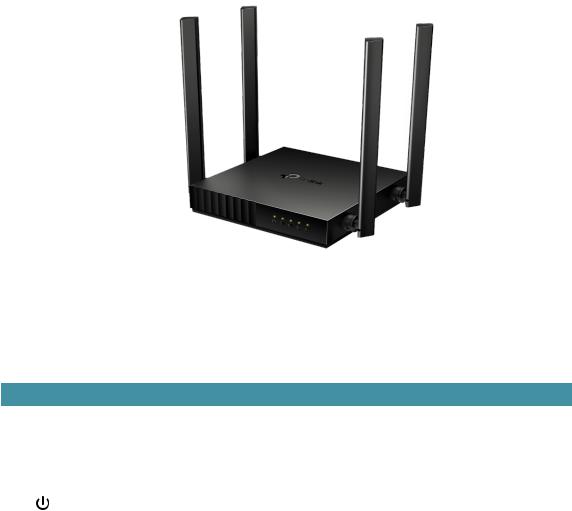
Chapter 1 |
Get to Know About Your Router |
1. 1. Product Overview
Enjoy internet with the dual-band Wi-Fi and 4 fast LAN ports. Equipped with 4 omnidirectional antennas, Archer C54 generates a 2.4 GHz Wi-Fi across your house and a fast 5 GHz Wi-Fi, letting the whole family enjoy reliable Wi-Fi on every device.
Moreover, it is simple and convenient to set up and use the TP-Link router due to its intuitive web interface and the powerful Tether app.
1. 2. Appearance
1. 2. 1. Top Panel
The router’s LEDs (view from left to right) are located on the front. You can check the router’s working status by following the LED Explanation table.
LED Explanation:
LED |
Status |
Indication |
|
|
On |
Power is on. |
|
|
|
Blinking slowly: |
|
|
Blinking |
The system is starting up or firmware upgrade is in progress. |
|
(Power) |
Blinking quickly: |
||
|
|||
|
|
WPS connection is in progress. |
|
|
|
|
|
|
Off |
Power is off. |
|
|
|
|
4

Chapter 1 Get to Know About Your Router
LED |
Status |
Indication |
|
(2.4GHz |
On |
The 2.4GHz wireless band is enabled. |
|
Wireless) |
Off |
The 2.4GHz wireless band is disabled. |
|
(5GHz |
On |
The 5GHz wireless band is enabled. |
|
Wireless) |
Off |
The 5GHz wireless band is disabled. |
|
|
On |
At least one powered-on device is connected to the router’s LAN |
|
(LAN) |
port. |
||
|
|||
Off |
No powered-on device is connected to the router’s LAN port. |
||
|
|||
|
|
Router Mode: Internet is available. |
|
|
Green On |
Access Point Mode: The WAN port is connected. |
|
|
|
Range Extender Mode: The router is connected to the host network. |
|
(Internet) |
Orange On |
The WAN port is connected, but internet is not available. |
|
|
Router Mode: The WAN port is not connected. |
||
|
|
||
|
Off |
Access Point Mode: The WAN port is not connected. |
|
|
Range Extender Mode: The router is not connected to the host |
||
|
|
||
|
|
network. |
1. 2. 2. The Back Panel
The following parts (view from left to right) are located on the back panel.
Button and Port Explanation
Item |
Description |
|
Power Port |
For connecting the router to a power socket via the provided power adapter. |
|
WAN Port |
For connecting to a DSL/Cable modem, or an Ethernet jack. |
|
LAN Ports (1/2/3/4) |
For connecting your PC or other wired devices to the router. |
|
|
Press the button for 1 second, and immediately press the WPS button on |
|
WPS/RESET Button |
your client to start the WPS process. |
|
Press and hold the button until all LEDs turn off to reset the router to its |
||
|
||
|
factory default settings. |
|
Antennas |
Used for wireless operation and data transmit. Upright them for the best |
|
Wi-Fi performance. |
||
|
5

Chapter 1 |
Get to Know About Your Router |
1. 2. 3. The Bottom
You can find the product label at the bottom of the router, then use default information on it to connect to the router.
 Note:
Note:
1.Use the default network names (SSIDs) and password to join the networks. Or scan the QR code to join the preset 2.4 GHz network directly.
2.Internet is not available until network setup completed.
6

Chapter 2
Connect to the Internet
This chapter contains the following sections:
•Position Your Router
•Connect to the Internet

Chapter 2 |
Connect to the Internet |
2. 1. Position Your Router
With the router, you can access your network from anywhere within the wireless network coverage. However, the wireless signal strength and coverage vary depending on the actual environment of your router. Many obstacles may limit the range of the wireless signal, for example, concrete structures or thick walls.
For your security and best Wi-Fi performance, please:
•Do NOT locate the router in a place where it will be exposed to moisture or excessive heat.
•Keep away from the strong electromagnetic radiation and the device of electromagnetic sensitive.
•Place the router in a location where it can be connected to the various devices as well as to a power source.
•Make sure the cables and power cord are safely placed out of the way to avoid a tripping hazard.
Generally, the router is placed on a horizontal surface, such as on a shelf or desktop. The device also can be mounted on the wall as shown in the following figure.
<![endif]>D
H
80
1. 2 3
<![if ! IE]><![endif]>14
A
NOTE:
4.87<D<10.37mm A(2/1) H<3mm
 Note:
Note:
The diameter of the screw, 4.87mm<D<10.37mm, and the distance of two screws is 80mm. The screw that project from the wall need around 4mm based, and the length of the screw need to be at least 20mm to withstand the weight of the product.
8

Chapter 2 |
Connect to the Internet |
2. 2. Connect to the Internet
The Router provides three working modes: Wireless Router, Range Extender and Access Point. You can choose the mode to better suit your network needs and follow the guide to complete the configuration.
2. 2. 1. Wireless Router Mode
1. Follow the steps below to connect your router.
If your internet connection is through an Ethernet cable from the wall instead of through a DSL / Cable / Satellite modem, connect the Ethernet cable directly to the router’s WAN port, and then follow Step 4 and 5 to complete the hardware connection.

 Important
Important
Unplug your modem, and remove the backup battery if it has one.
Power adapter |
Router |
Modem |
|
Connect the powered-off modem to the router’s WAN port via an Ethernet cable.
Connect the power adapter to the router.
Connect to the internet
Connect to the power socket
Power on the modem and then wait about 2 minutes for it to restart.
Verify that the  LED turns solid on before continuing.
LED turns solid on before continuing.
1 ) |
Power off the modem, and remove the backup battery if it has one. |
2 ) |
Connect the powered-off modem to the router’s WAN port with an Ethernet |
|
cable. |
3 ) |
Turn on the modem, and then wait about 2 minutes for it to restart. |
4 ) |
Connect the power adapter to the router. |
5 ) |
Verify that the internet LED turns solid before continuing with the configuration. |
2.Connect your computer to the router.
•Method 1: Wired
Turn off the Wi-Fi on your computer and connect your computer to the router’s LAN port.
9
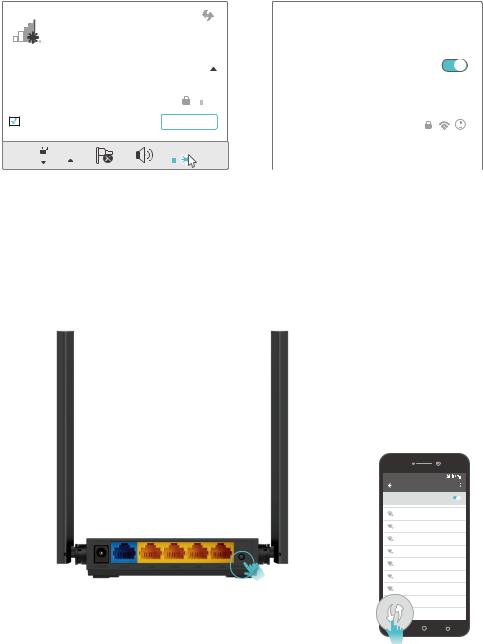
Chapter 2 |
Connect to the Internet |
•Method 2: Wireless
1 ) Connect your device to the router’s Wi-Fi using the SSID (network name) and Wireless Password printed on the label at the bottom of the router.
2 ) Click the network icon of your computer or go to Wi-Fi Settings of your smart device, and then select the SSID to join the network.
 Note: If you are using a smart device, you can also scan the QR code to join the preset 2.4 GHz network directly.
Note: If you are using a smart device, you can also scan the QR code to join the preset 2.4 GHz network directly.
|
|
|
Computer |
|
|
|
|
|
|
|
|
|
|
|
|
|
Smart Device |
||
|
|
|
Connections are available |
|
< Settings |
Wi-Fi |
|||||||||||||
|
|
|
|
|
|
|
|
||||||||||||
|
|
|
|
|
|
|
|
||||||||||||
|
|
|
|
|
|
|
|||||||||||||
|
|
|
|
|
|
|
|
|
|
|
|
|
|
|
|
|
|
|
|
|
|
|
|
|
|
|
|
|
|
|
|
|
|
|
|
Wi-Fi |
|
|
|
Wireless Network Connection |
|
|
|
|
|
|
|
|
|
OR |
|
|
|
||||||
|
|
|
|
|
|
|
|
|
|
|
|
|
CHOOSE A NETWORK... |
||||||
TP-Link_XXXX |
|
|
|
|
|
|
|
|
|
||||||||||
|
|
|
|
|
|
|
|
||||||||||||
|
|
|
|
|
|
|
|
|
|
|
|
|
|
|
|
||||
|
Connect automatically |
Connect |
TP-Link_XXXX |
|
|
||||||||||||||
|
|
||||||||||||||||||
|
|
||||||||||||||||||
|
|
|
|
|
|
|
|
|
|
|
|
|
|
|
|
Other... |
|
|
|
|
|
|
|
|
|
|
|
|
|
|
|
|
|
|
|
|
|
|
|
|
|
|
|
|
|
|
|
|
|
|
|
|
|
|
|
|
|
|
|
•Method 3: Use the WPS button
Wireless devices that support WPS, including Android phones, tablets, most USB network cards, can be connected to your router through this method.
 Note:
Note:
•WPS is not supported by iOS devices.
•The WPS function cannot be configured if the wireless function of the router is disabled. Also, the WPS function will be disabled if your wireless encryption is WEP. Please make sure the wireless function is enabled and is configured with the appropriate encryption before configuring the WPS.
1 ) |
Tab the WPS icon on the device’s screen. Here we take an Android phone as an |
|
example. |
2 ) |
Immediately press the WPS button on your router. |
Close to
WLAN
On
TP-Link
HomeNetwork
Office
TP-Link_123
TP-Link_ABC
MyHome
Test
3.Enter http://tplinkwifi.net in the address bar of a web browser. Create a password to log in.
10
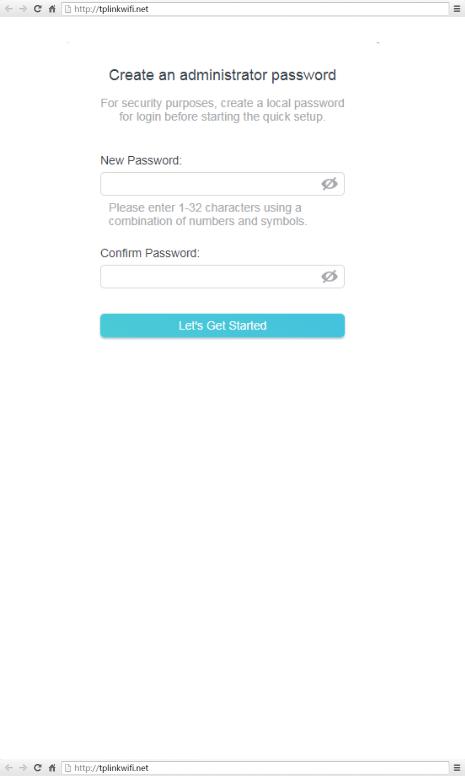
Chapter 2 |
Connect to the Internet |
||
|
|
|
|
|
|
|
|
 Note:
Note:
If the above screen does not pop-up, it means that your IE Web-browser has been set to a proxy. Go to menu Tools > Internet Options > Connections > LAN Settings, in the screen that appears, untick the Using Proxy checkbox, and click OK.
4.Follow the Quick Setup to set up the internet connection.
5.Enjoy! For wireless devices, you may have to reconnect to the wireless network if you have customized the SSID (wireless name) and password during the configuration.
2. 2. 2. Range Extender Mode
This mode boosts your home wireless coverage.
1.Connect the power adapter to the router.
2.Connect a computer to the router via an Ethernet cable or wirelessly by using the SSID (wireless name) and password printed on the bottom label of the router.
3.Enter http://tplinkwifi.net in the address bar of a web browser. Create a password to log in.
11
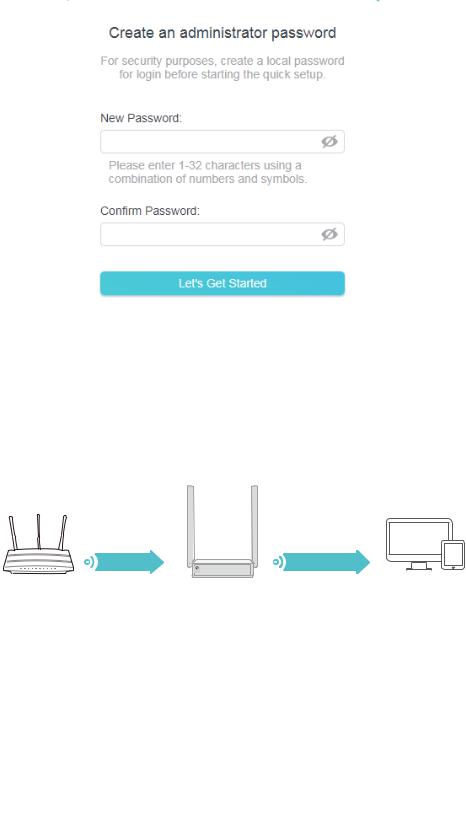
Chapter 2 |
Connect to the Internet |
||
|
|
|
|
|
|
|
|
4.Click Change Mode in the top right corner and select Range Extender Mode. Wait for the router to reboot.
5.Follow the Quick Setup to set up the internet connection.
6.Relocate: Place the router between your host router and the Wi-Fi dead zone. The location you choose must be within the range of your existing host network.
|
Host Network |
Extended Network |
Host Router |
Router |
Devices |
7. Enjoy! You can customize the SSID and password of the extended network.
2. 2. 3. Access Point Mode
This mode transforms your existing wired network to a wireless network.
Internet |
Ethernet1 |
Ethernet2 |
Wired Router |
Router |
Devices |
1. Connect the power adapter to the router.
12
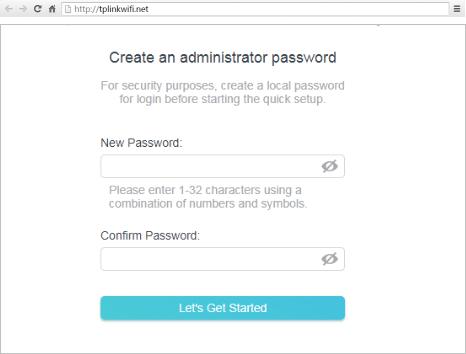
Chapter 2 |
Connect to the Internet |
2.Connect the router to your wired host router’s Ethernet port via an Ethernet cable as shown above.
3.Connect a computer to the router via an Ethernet cable or wirelessly by using the SSID (network name) and password printed on the bottom label of the router.
4.Enter http://tplinkwifi.net in the address bar of a web browser. Create a password to log in.
 Note:
Note:
If the above screen does not pop-up, it means that your IE Web-browser has been set to a proxy. Go to menu Tools > Internet Options > Connections > LAN Settings, in the screen that appears, untick the Using Proxy checkbox,
and click OK.
5.Click Change Mode in the top right corner and select Access Point Mode. Wait for the router to reboot.
6.Follow the Quick Setup to set up the internet connection.
7.Enjoy! Connect to the wireless network by using the SSID (network name) and password of the router.
13

Chapter 3
Log In to the Router
This chapter introduces how to log in to the web management page of the router.
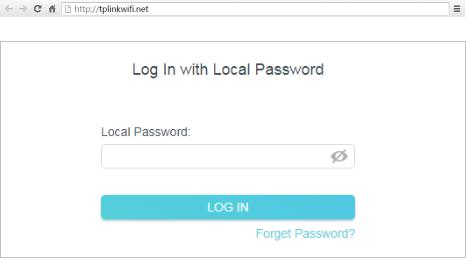
Chapter 3 |
Log In to the Router |
With the web-based utility, it is easy to configure and manage the router. The webbased utility can be used on any Windows, Macintosh or UNIX OS with a Web browser, such as Microsoft the Internet Explorer, Mozilla Firefox or Apple Safari.
Follow the steps below to log in to your router.
1.Set up the TCP/IP Protocol in Obtain an IP address automatically mode on your computer.
2.Visit http://tplinkwifi.net, and log in with the password you set for the router.
 Note:
Note:
If the login window does not appear, please refer to the FAQ section.
15

Chapter 4
Configure the Router in
Wireless Router Mode
This chapter presents how to configure the various features of the router working as a wireless router.
It contains the following sections:
•Operation Mode
•Network
•Wireless
•NAT Forwarding
•Parental Controls
•QoS
•Security
•IPv6
•System
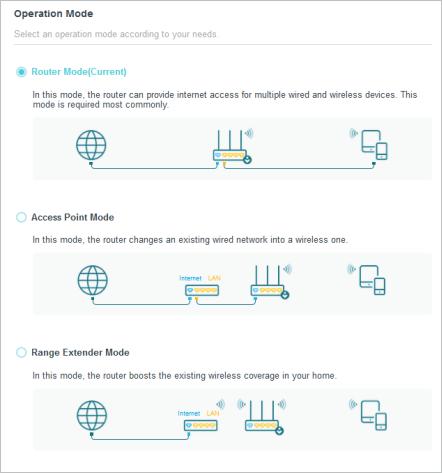
Chapter 4 |
Configure the Router in Wireless Router Mode |
4. 1. Operation Mode
1.Visit http://tplinkwifi.net, and log in with the password you set for the router.
2.Go to Advanced > Operation Mode.
3.Select the working mode as needed and click SAVE.
4. 2. Network
4. 2. 1. Status
1.Visit http://tplinkwifi.net, and log in with password you set for the router.
2.Go to Advanced > Network > Status. You can view the current status information of the router.
17

Chapter 4 |
Configure the Router in Wireless Router Mode |
||
|
|
|
|
|
|
|
|
•Internet - This field displays the current settings of the internet, and you can configure them on the Advanced > Network > Internet page.
•Status - Indicates whether the router has been connected to the internet.
•Internet Connection Type - Indicates the way in which your router is connected to the internet.
•IP Address - The WAN IP address of the router.
•Subnet Mask - The subnet mask associated with the WAN IP address.
•Default Gateway - The Gateway currently used is shown here. When you use Dynamic IP as the internet connection type, click Renew or Release here to obtain new IP parameters dynamically from the ISP or release them.
•Primary & Secondary DNS - The IP addresses of DNS (Domain Name System) server.
18
Chapter 4 |
Configure the Router in Wireless Router Mode |
•LAN - This field displays the current settings of the LAN, and you can configure them on the Advanced > Network > LAN page.
•MAC Address - The physical address of the router.
•IP Address - The LAN IP address of the router.
•Subnet Mask - The subnet mask associated with the LAN IP address.
•DHCP Server - This field displays the current settings of DHCP (Dynamic Host Configuration Protocol) Server, and you can configure them on the Network > DHCP Server page.
•DHCP Server - Indicates whether the DHCP server is enabled of disabled. It is enabled by default and the router acts as a DHCP server.
•IP Address Pool - The IP address range for the DHCP server to assign IP addresses.
•Dynamic DNS - This field displays the current settings of the Dynamic DNS (Domain Name System), and you can configure them on the Advanced > Network > Dynamic DNS page.
•Service Provider - The Dynamic DNS service provider you have signed up for.
•Host Name - The Domain Name you have entered in the Dynamic DNS page.
•Status - The status of the Dynamic DNS service conenction.
4. 2. 2. Internet
1.Visit http://tplinkwifi.net, and log in with the password you set for the router.
2.Go to Advanced > Network > Internet.
3.Set up the internet connection and click SAVE.
Dynamic IP
If your ISP provides the DHCP service, please select Dynamic IP, and the router will automatically get IP parameters from your ISP.
Click Renew to renew the IP parameters from your ISP. Click Release to release the IP parameters.
19
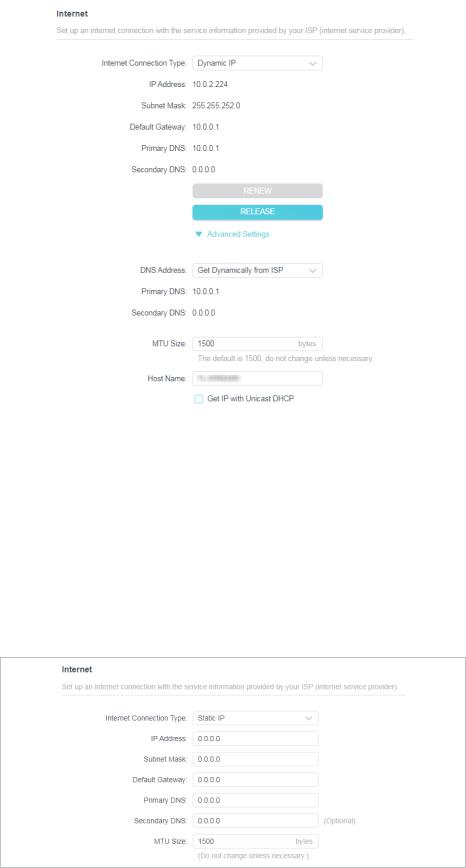
Chapter 4 |
Configure the Router in Wireless Router Mode |
||
|
|
|
|
|
|
|
|
•MTU Size - The normal MTU (Maximum Transmission Unit) value for most Ethernet networks is 1500 Bytes. It is not recommended that you change the default MTU size unless required by your ISP.
•Host Name -This option specifies the name of the router.
•GetIPwithUnicastDHCP-AfewISPs’DHCPserversdosupportthebroadcastapplications. If you cannot get the IP address normally, you can choose this option (it is rarely required).
Static IP
If your ISP provides a static or fixed IP address, subnet mask, default gateway and DNS setting, please select Static IP.
20
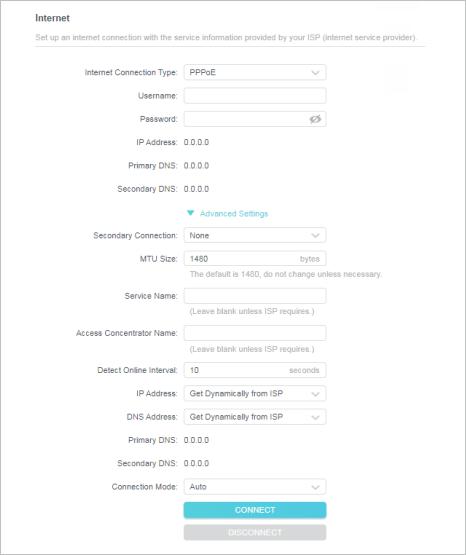
Chapter 4 |
Configure the Router in Wireless Router Mode |
•IP Address - Enter the IP address in dotted-decimal notation provided by your ISP.
•Subnet Mask - Enter the subnet mask in dotted-decimal notation provided by your ISP. Normally 255.255.255.0 is used as the subnet mask.
•Default Gateway - Enter the gateway IP address in dotted-decimal notation provided by your ISP.
•Primary/Secondary DNS - (Optional) Enter one or two DNS addresses in dotteddecimal notation provided by your ISP.
•MTU Size - The normal MTU (Maximum Transmission Unit) value for most Ethernet networks is 1500 Bytes. It is not recommended that you change the default MTU size unless required by your ISP.
PPPoE
If your ISP provides PPPoE connection, select PPPoE.
21
Chapter 4 |
Configure the Router in Wireless Router Mode |
•User Name/Password - Enter the user name and password provided by your ISP. These fields are case-sensitive.
•Secondary Connection - It’s available only for PPPoE connection. If your ISP provides an extra connection type, select Dynamic IP or Static IP to activate the secondary connection.
•MTU Size - The default MTU size is 1480 bytes. It is not recommended that you change the default MTU size unless required by your ISP.
•Service Name - The service name should not be configured unless you are sure it is necessary for your ISP. In most cases, leaving these fields blank will work.
•Access Concentrator Name - The access concentrator name should not be configured unless you are sure it is necessary for your ISP. In most cases, leaving these fields blank will work.
•Detect Online Interval - The router will detect Access Concentrator online at every interval. The default value is 10. You can input the value between 0 and 120. The value 0 means no detect.
•IP Address - The default setting is to get an IP address dynamically from your ISP. If your ISP does not automatically assign IP addresses to the router, please select Use the Following IP Address and enter the IP address provided by your ISP in dotteddecimal notation.
•DNS Address - The default setting is to get an IP address dynamically from your ISP.If your ISP does not automatically assign DNS addresses to the router, please select Use the Following DNS Addresses and enter the IP address in dotted-decimal notation of your ISP’s primary DNS server. If a secondary DNS server address is available, enter it as well.
•Connection Mode - Select an appropriate connection mode that determines how to connect to the internet.
•Auto - In this mode, the internet connection reconnects automatically any it gets disconnected.
•On Demand - In this mode, the internet connection will be terminared automatically after a specified inactivity period (Max Idle Time) and be reestablished when you attempt to access the internet again.
•Time-based - In this mode, the internet connection is only established in a specific timeframe. If this option is selected, enter the start time and end time. Both are in HH:MM format.
•Manual - In this mode, the internet connection is controlled manually by clicking the Connect/Disconnect button. This mode also supports the Max Idle Time function as On Demand mode. Enter a maximum time (in minutes), the internet connection can be inactive before it is terminated into the Max Idle Time. The
22
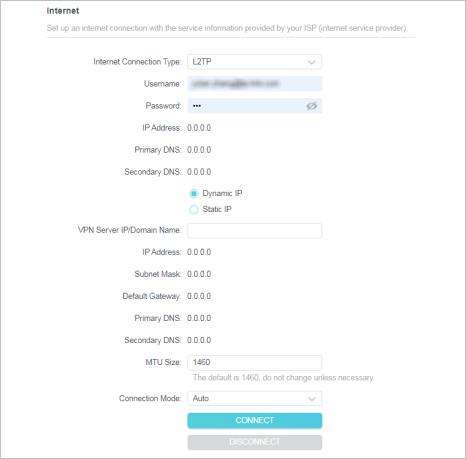
Chapter 4 |
Configure the Router in Wireless Router Mode |
default value is 15 minutes. If you want the internet connection remains active all the time, enter 0 (zero).
 Note:
Note:
Sometimes the connection cannot be terminated although you have specified the Max Idle Time because some applications are visiting the internet continually in the background.
L2TP
If your ISP provides L2TP connection, please select L2TP.
•Username/Password - Enter the username and password provided by your ISP. These fields are case-sensitive.
•VPN Server IP/ Domain Name - Enter the VPN server’s IP address or domain name provided by your ISP.
•MTU Size - The default MTU size is “1460” bytes, which is usually fine. It is not recommended that you change the default MTU Size unless required by your ISP.
•Connection Mode
•Auto - In this mode, the internet connection reconnects automatically any it gets disconnected.
23
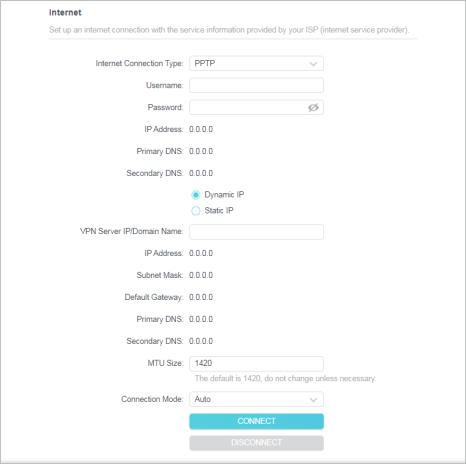
Chapter 4 |
Configure the Router in Wireless Router Mode |
•On Demand - In this mode, the internet connection will be terminared automatically after a specified inactivity period (Max Idle Time) and be reestablished when you attempt to access the internet again.
•Manual - In this mode, the internet connection is controlled manually by clicking the Connect/Disconnect button. This mode also supports the Max Idle Time function as On Demand mode. Enter a maximum time (in minutes), the internet connection can be inactive before it is terminated into the Max Idle Time. The default value is 15 minutes. If you want the internet connection remains active all the time, enter 0 (zero).
 Note:
Note:
Sometimes the connection cannot be terminated although you have specified the Max Idle Time because some applications are visiting the internet continually in the background.
PPTP
If your ISP provides PPTP connection, please select PPTP.
•Username/Password - Enter the username and password provided by your ISP. These fields are case-sensitive.
24
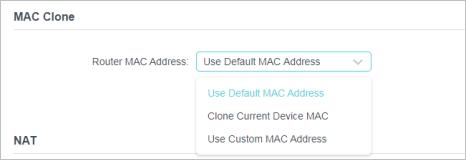
Chapter 4 |
Configure the Router in Wireless Router Mode |
•VPN Server IP/ Domain Name - Enter the VPN server’s IP address or domain name provided by your ISP.
•MTU Size - The default MTU size is “1420” bytes, which is usually fine. It is not recommended that you change the default MTU Size unless required by your ISP.
•Connection Mode
•Auto - In this mode, the internet connection reconnects automatically any it gets disconnected.
•On Demand - In this mode, the internet connection will be terminared automatically after a specified inactivity period (Max Idle Time) and be reestablished when you attempt to access the internet again.
•Manual - In this mode, the internet connection is controlled manually by clicking the Connect/Disconnect button. This mode also supports the Max Idle Time function as On Demand mode. Enter a maximum time (in minutes), the internet connection can be inactive before it is terminated into the Max Idle Time. The default value is 15 minutes. If you want the internet connection remains active all the time, enter 0 (zero).
 Note:
Note:
Sometimes the connection cannot be terminated although you have specified the Max Idle Time because some applications are visiting the internet continually in the background.
4. 2. 3. MAC Clone
1.Visit http://tplinkwifi.net, and log in with the password you set for the router.
2.Go to Advanced > Network > Internet and locate the MAC Clone section.
3.Configure the WAN MAC address and click SAVE.
•Use Default MAC Address - Do not change the default MAC address of your router in case the ISP does not bind the assigned IP address to the MAC address.
•Use Current MAC Address - Select to copy the current MAC address of the computer that is connected to the router, in case the ISP binds the assigned IP address to the MAC address.
25

Chapter 4 |
Configure the Router in Wireless Router Mode |
•Use Custom MAC Address - Select if your ISP requires you to register the MAC address and enter the correct MAC address in this field, in case the ISP binds the assigned IP address to the specific MAC address.
 Note:
Note:
•You can only use the MAC Address Clone function for PCs on the LAN.
•If you have changed the WAN MAC address when the WAN connection is PPPoE, it will not take effect until the connection is re-established.
4. 2. 4. LAN
1.Visit http://tplinkwifi.net, and log in with the password you set for the router.
2.Go to Advanced > Network > LAN.
3.Configure the IP parameters of the LAN and click SAVE.
•MAC Address - The physical address of the LAN ports. The value can not be changed.
•IP Address - Enter the IP address in dotted-decimal notation of your router (the default one is 192.168.0.1).
•Subnet Mask - An address code that determines the size of the network. Normally 255.255.255.0 is used as the subnet mask.
 Note:
Note:
•If you have changed the IP address, you must use the new IP address to log in.
•If the new IP address you set is not in the same subnet as the old one, the IP address pool in the DHCP Server will be configured automatically, but the Virtual Server and DMZ Host will not take effect until they are re-configured.
4. 2. 5. IPTV
1.Visit http://tplinkwifi.net, and log in with the password you set for the router.
2.Go to Advanced > Network > IPTV/VLAN.
3.Configure the WAN MAC address and click Save.
26
